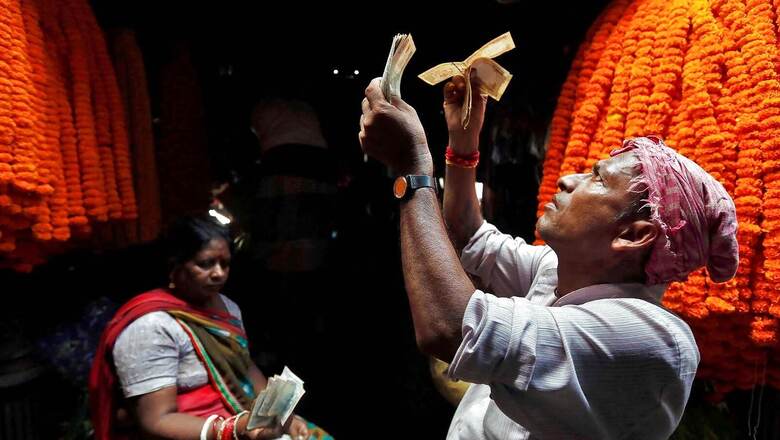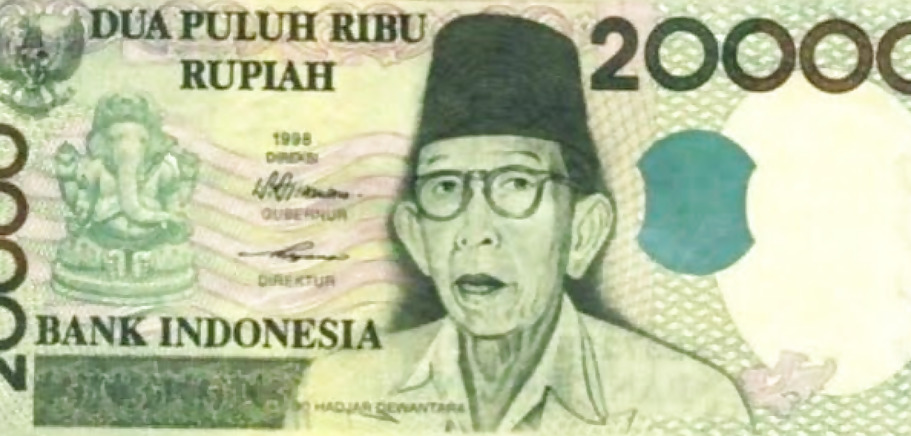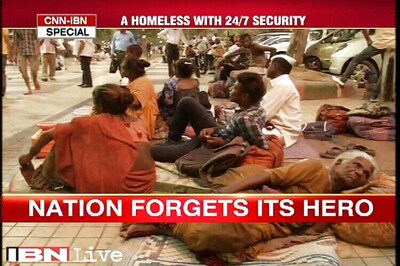
views
Cashing in on the currency controversy, various leaders gave their cents on the issue after Delhi Chief Minister Arvind Kejriwal made headlines with his request to include Hindu god and goddess Ganesh and Laxmi on Indian notes. While many called the remark ‘politically motivated’, others chirped in with their own versions of currency – with pictures of Shivaji, or BR Ambedkar.
BJP spokesperson Ram Kadam also piped in the debate demanding that images of Babasaheb Ambedkar, Shivaji, Vinayak Damodar Savarkar, and Prime Minister Narendra Modi be printed on currency notes.
अखंड भारत.. नया भारत.. महान भारत.. जय श्रीराम .. जय मातादी ! pic.twitter.com/OPrNRu2psl
— Ram Kadam (@ramkadam) October 27, 2022
Currently, the Rs 500/- note features the intaglio printing of Mahatma Gandhi’s portrait, the Ashoka Pillar emblem, bleed lines and a circle with Rs 500 inside. It is a part of the new E series where the bottom left corner of every note is marked with the letter E, an analysis of Indian bank notes by Shutterstock reveals.
Kejriwal has meanwhile drummed up a contentious debate after saying that photos of Hindu god Ganesha and Goddess Lakshmi should be carried out on currency notes. He added that the new notes could have a picture of Mahatma Gandhi on one side and of the two deities on the other.
“Despite making efforts, sometimes our efforts do not fructify if gods and goddesses are not blessing us. I appeal to PM (Modi) to have photos of Lord Ganesha and Goddess Laxmi on our currency (notes). If there is a photo of Lakshmi-Ganesha on our currency (notes), our country will prosper. I will write to (the) prime minister in a day or two on this,” he said.
With an imbroglio of political reaction on the issue, it is unclear whether the demand will be taken seriously, considering the ample and diverse suggestions which have followed up Kejriwal’s. His demand, however, drew sharp reactions from the BJP, which called it an unsuccessful attempt to hide the “ugly anti-Hindu face” of AAP in view of upcoming elections in Gujarat and Himachal Pradesh. Former AAP leader Ashutosh mocked Kejriwal and said Prime Minister Narendra Modi should follow the AAP chief’s advice and immediately “sack all economic advisors”. Singer Vishal Dadlani also expressed his aversion to the idea. He has backed AAP on previous occasions.
The Constitution of India states that we are a Secular Socialist Republic. Hence, religion must have NO PLACE in governance.
To be completely clear, I have nothing to do with anyone who brings any part of any religion to any aspect of government.
Jai Hind. ????????
— VISHAL DADLANI (@VishalDadlani) October 26, 2022
Can it Legally be Implemented?
The responsibility of printing and management of the currency notes according to the Constitution is entrusted to the Reserve Bank of India. It is the RBI that can actually make the requisite tweaks to the currency notes. As per Section 25 of the Reserve Bank of India (RBI) Act, 1934, “The design, form and material of bank notes shall be such as may be approved by the [Central Government] after consideration of the recommendations made by Central Board.”
The Reserve Bank’s affairs are governed by a central board of directors. The board is appointed by the Government of India in keeping with the Reserve Bank of India Act. Read more
In 2014, the Delhi High Court had questioned the Centre’s decision to commemorate religious events by issuing coins with images of deities embossed on them, stating that “our Constitution does not permit this.” “Religious issues cannot be addressed by the state. Put an end to such behaviour. You are commemorating a specific religion by issuing a coin,” the bench had said, according to a report by the Economic Times.
An RTI Reply that May Stump Kejriwal’s Demand
Amidst the row, a report by IANS said the Reserve Bank of India (RBI) and the Centre had already put a lid on the issue way back in 2010. An RTI reply to this effect on the Indian Currency Note (ICN) was sent by the Department of Economic Affairs’ Additional Secretary Manisha Sinha to a Pune businessman Prafful Sarda in 2019.
The government said that a high-level panel (October 2010) constituted by the RBI had deliberated at length on the need for inclusion of other eminent personalities, Bharat Ratnas, Nobel laureates, freedom fighters or sports persons on the ICN design.
The High-Level Screening Committee – set up on the advice of the then Government of Prime Minister Dr. Manmohan Singh – felt that “no other personality could better represent the ethos of India better than Mahatma Gandhi”.
“Therefore, it was decided to retain the portrait of Mahatma Gandhi on the obverse of banknotes and on the watermark. Government has approved the recommendation,” declared the RTI reply of November 11, 2019, sent from the North Block.
“I had asked the PMO to consider printing the photos of Dr. B.R. Ambedkar or Sardar Patel on the ICN after which the government gave the reply and the matter rested. It proves that the Delhi CM has only vested political motives behind his latest demand,” Sarda said. The plea to the PMO was in view of the various demands to add pictures of other personalities on ICNs that keep cropping up frequently, he added.
Later, a former MP of All India Trinamool Congress and former cricketer Kirti Azad had raised the issue in Parliament for including other prominent personalities on the ICNs, but the Finance Minister Arun Jaitley had cited the RBI panel’s report in response.
What About Other Countries?
In his speech requesting the change, the AAP national convener said his suggestion was not against anyone, adding that even Indonesia, a Muslim country with less than two per cent Hindus and more than 85 per cent Muslims, had images of Lord Ganesha on its currency notes.

However, most modern currencies have images of their most revered leaders on it, along with motifs that may seem religious but hold ideological significance to the country’s ideals. As an example, China’s currency or renminbi (CNY), abbreviated (RMB), translates literally as “People’s currency” in English.
A 5 yuan note depicts a portrait of Mao Zedung, a famous Chinese leader who not only led the country’s communist revolution but was also the chairman of the People’s Republic of China—the words translated in English next to his picture. When looking at higher-value Chinese banknotes, one can notice that Zedong’s face appears on all of China’s recent currency ranging from 1 to 100.
The back of the note depicts Mount Tai, a beloved symbol in Chinese culture that represents renewal and sunrise. It has long been a place of worship and is now one of China’s most popular tourist destinations. Every yuan depicts a different landmark on the back of the bill to represent China’s land and people, said a report by Bank Note World.
Meanwhile, US currency versions have included former presidents, leaders of the country and important institutional buildings. The modern era of US currency began in 1913, when the Federal Reserve Act established the Federal Reserve as the nation’s central bank. The Federal Reserve began issuing new bills known as Federal Reserve notes in 1914 — the same money we used today. Since then, four portraits have changed on bills, though two of those changes occurred on denominations that are no longer printed.
Is the Demand Political?
The Aam Aadmi party has been putting its best foot forward to gain ground in Gujarat and Himachal Pradesh ahead of the fast-approaching assembly elections. Its political adversaries related Kejriwal’s demand to those motives.
While some called the demand exclusionary, other were quick to point out the ‘superstitious’ nature behind the request, as they said such a move would not logically help against the current economic woes being faced in the country such as unemployment and inflation.
But Kejriwal has maintained his demand, saying the printing of the images would help tide over India’s economic problems. Both the idols are worshipped in Hindu religion often for prosperity and material gain.
Does the Look of Currency Actually Have an Effect on the Economy?
Some experts believe so, but perhaps not in the exact way Kejriwal has proposed. According to a research article by Fabrizio Di Muro and Theodore J Noseworthy, the physical appearance of money can override the influence of denomination. “The reason being, people want to rid themselves of worn bills because they are disgusted by the contamination from others, whereas people put a premium on crisp currency because they take pride in owning bills that can be spent around others,” reads the abstract of the study.
Meanwhile, Dr Julia Pitters, a professor and head of the Business Psychology program at IU International University of Applied Sciences had said in a report that in terms of economic psychology, when people see or possess cash, something changes in their brains and their thinking.
“This “monetary stimulus” does something to us; it triggers a kind of “goal attainment reflex.” We want to have it and own it; it makes us more ambitious. Cash alternatives don’t trigger something like that yet. These triggers, these stimuli work best with the haptics of real money,” she had said, adding the design may too play a role. Giving the example of the Euro banknotes, she said the European Central Bank has achieved what every country, every region, and every government strives for: universal identification. “The countries in the eurozone have identified themselves with the EU far more strongly than those that have not joined the monetary union,” she said.
Read all the Latest Explainers here

















Comments
0 comment